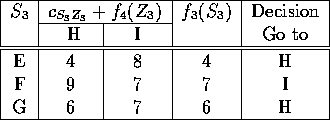
Figure 2: Road Network
Dynamic programming may look somewhat familiar. Both our shortest path algorithm and our method for CPM project scheduling have a lot in common with it.
Let's look at a particular type of shortest path problem. Suppose we wish to get from A to J in the road network of Figure 2.
The numbers on the arcs represent distances. Due to the special structure of this problem, we can break it up into stages. Stage 1 contains node A, stage 2 contains nodes B, C, and D, stage 3 contains node E, F, and G, stage 4 contains H and I, and stage 5 contains J. The states in each stage correspond just to the node names. So stage 3 contains states E, F, and G.
If we let S denote a node in stage j
and let ![]() be the shortest distance from node S to the
destination J, we can write
be the shortest distance from node S to the
destination J, we can write
![]()
where ![]() denotes the length of arc SZ.
This gives the recursion needed to solve this problem. We begin by
setting
denotes the length of arc SZ.
This gives the recursion needed to solve this problem. We begin by
setting ![]() . Here are the rest of the calculations:
. Here are the rest of the calculations:
The next table gives all the calculations:


